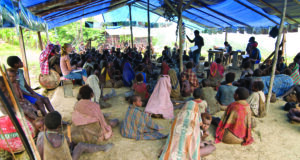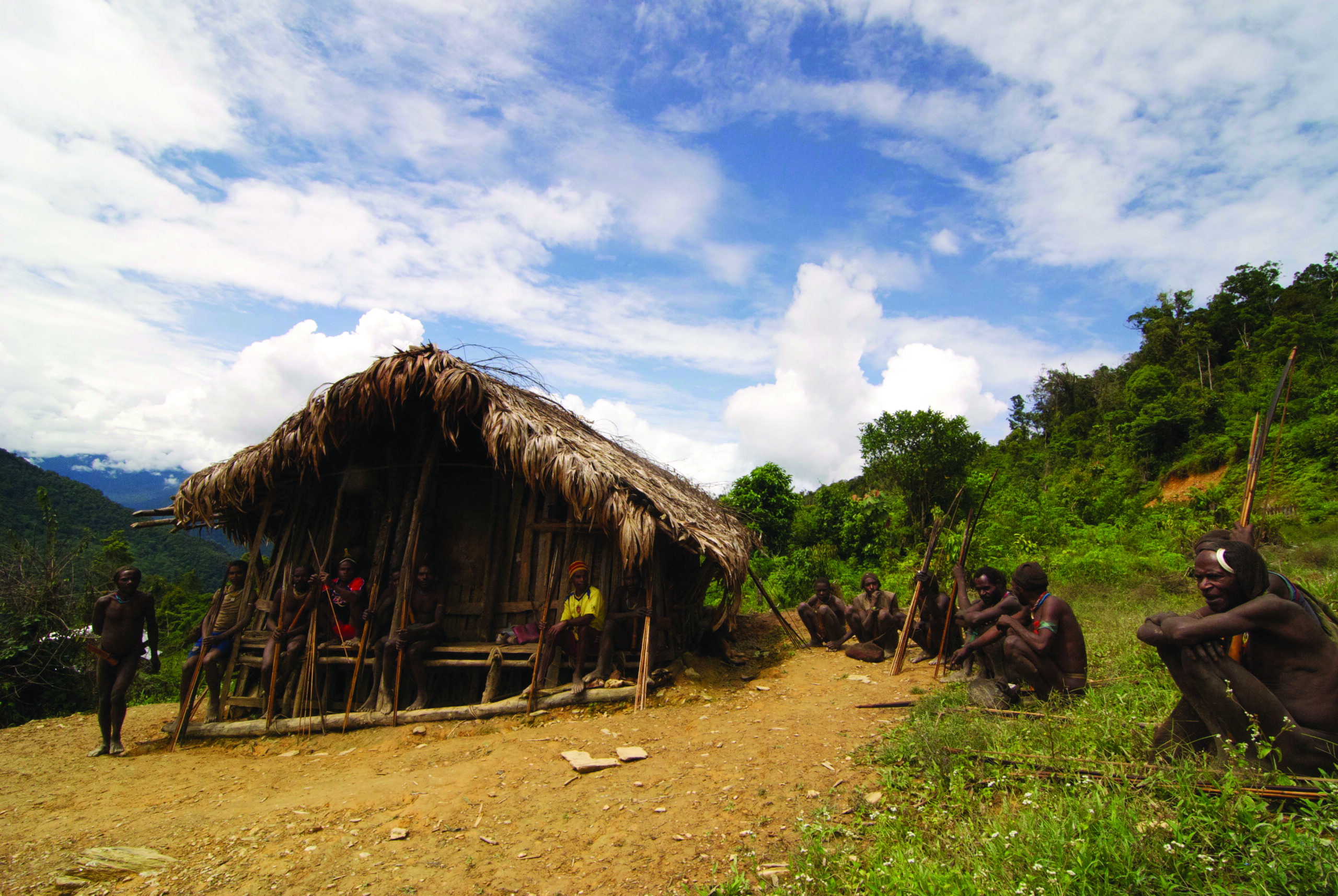For centuries the Moi people of Papua, Indonesia1 remained almost entirely untouched by the outside world. These semi-nomadic hamlet dwellers eked out a living through slash and burn gardening, and frequent hunting excursions throughout the 300 square miles of mountainous jungles they call home. Approximately 1,000 strong, the Moi were sparsely scattered through their vast land. They were as close to nature as anyone could get.
 But unlike a utopian society envisaged by the cold and distant – the ones who like to say, “Leave them alone, they’re happy the way they are”, the Moi lived in constant fear of death from the spirits and one another. With the infant mortality rate close to 80%2 and the average life-span to be no more than 40 years old, death was a frequent visitor. Compounding the fear of death was the fact that the Moi believed that every-single death had to do with spirits, all of whom had voracious appetites for humans. Hebrews 2:15 describes their darkness, “…who through fear of death were subject to lifelong slavery.”
But unlike a utopian society envisaged by the cold and distant – the ones who like to say, “Leave them alone, they’re happy the way they are”, the Moi lived in constant fear of death from the spirits and one another. With the infant mortality rate close to 80%2 and the average life-span to be no more than 40 years old, death was a frequent visitor. Compounding the fear of death was the fact that the Moi believed that every-single death had to do with spirits, all of whom had voracious appetites for humans. Hebrews 2:15 describes their darkness, “…who through fear of death were subject to lifelong slavery.”
In order to remain alive as long as possible, the Moi would do all they could to remain hidden from the spirits. They believed the spirits lived underground coming up through holes in the ground to hunt for people. Avoiding taboo foods, carrying powerful objects, and skirting “dangerous areas” were ways to remain invisible. Some of the Moi took extra steps to learn chants and rituals that could be used to manipulate the spirits for both good and evil.
 If that didn’t make life difficult enough, the Moi were also afraid of one another. Rampant infidelity and never-ending cycles of murder, retaliation, and compensation created a thick cloud of distrust. This greatly contributed to the vast separation between hamlets. One or two grass roofed huts were often separated by miles of jungle before reaching the next small cluster of houses.
If that didn’t make life difficult enough, the Moi were also afraid of one another. Rampant infidelity and never-ending cycles of murder, retaliation, and compensation created a thick cloud of distrust. This greatly contributed to the vast separation between hamlets. One or two grass roofed huts were often separated by miles of jungle before reaching the next small cluster of houses.
This was the situation when the Moi were first discovered by missionary pilots who had been flying over “Point X-Ray.” It was there, where three rivers intersected, that a team of three families affiliated with Ethnos3603 would eventually make their homes. In June of 2000 the work began. Motivated by the love of Christ (Matt. 28:18-20) and a keen awareness that apart from hearing and believing the gospel the world has no hope (Rom. 10:13-15); these families left their respective homes in America, Canada, and Sulawesi, Indonesia to live among the Moi. In 2005, our family joined the work to replace the family from Canada who had to leave due to health reasons. Helimission provided the initial helicopter support to get set up and maintain a full-time presence with the Moi. In 2007 the airstrip carved into the mountainside was completed allowing fix wing flight support by MAF and JAARS4.
 The team was warmly welcomed by the Moi people. The provision of basic medicine and healthcare helped to grow the relationships. Yet, despite the many lives saved by our team there was still an underlying mistrust. As happens with many of the Moi women, my wife Karen was even accused of manipulating the spirits to eat them. All the while enjoying the benefits of our presence, there was the prevailing thought that the only reason our team wanted to live there was because we wanted something from them. Why else would we leave our families and homelands?
The team was warmly welcomed by the Moi people. The provision of basic medicine and healthcare helped to grow the relationships. Yet, despite the many lives saved by our team there was still an underlying mistrust. As happens with many of the Moi women, my wife Karen was even accused of manipulating the spirits to eat them. All the while enjoying the benefits of our presence, there was the prevailing thought that the only reason our team wanted to live there was because we wanted something from them. Why else would we leave our families and homelands?
Today, in 2017, it is estimated that there are 7,099 living languages. Of those, 3,233 like the Moi, do not have a writing system. Since our goal was not to just share the gospel with the Moi, but rather make disciples of Jesus who make more disciples, we needed more than just the ability to learn the culture and speak the language. We needed to provide the written Word of God for them. The ability to study the scriptures has been necessary for our growth and would likewise be necessary for the future Moi church. The Moi needed their own Bible translation. So applying cross-cultural missions training5 the team was able to develop a working alphabet and reduce the oral language into writing. In preparation for seeing a mature church established, another major hurdle to overcome was the fact that the Moi had no concept of God. All they knew about were evil spirits. Taking the Moi term for create “ane-gi-se,” and adding “mee” (person), the key term for God was developed, Anegisemee, the Creator God.
 The years of language and culture study, followed by many months of Moi Bible translation, initial development of Moi foundational Bible teaching lessons, and a literacy program would eventually pay off. Finally, in November 2005, the team was ready to teach “The Creator’s Talk.” In order to give the best possible chance for the Moi to understand that Jesus is the Son of God, who paid for the sins of the world, we needed to start first with the basics of who God is. Following the counsel and experience of others, instead of commencing from somewhere in the middle of the Bible, we started “His Story” in the beginning with Genesis.
The years of language and culture study, followed by many months of Moi Bible translation, initial development of Moi foundational Bible teaching lessons, and a literacy program would eventually pay off. Finally, in November 2005, the team was ready to teach “The Creator’s Talk.” In order to give the best possible chance for the Moi to understand that Jesus is the Son of God, who paid for the sins of the world, we needed to start first with the basics of who God is. Following the counsel and experience of others, instead of commencing from somewhere in the middle of the Bible, we started “His Story” in the beginning with Genesis.
Eight of the Moi stayed for more than a month to listen to all the lessons that took them from creation to Christ. They carefully tracked the Old Testament stories, and like OT saints were looking forward to how God would fulfill His promise to send the Messiah. They had no idea it was going to be Jesus. When he was finally revealed as the fulfillment of the promise, they were ecstatic and soon fell in love with Him. God the Son, in the flesh, loving sinners, working miracles, rebuking the proud, resisting the Devil, and finally paying the penalty that we all deserved for our sins…death. We ended the teaching with a drama portraying Jesus’ death, burial, and resurrection. Afterwards we reviewed all the pictures we used throughout the teaching, pointing to shadows of Christ’s future work, in stories like Noah’s ark and the one door, the ram that took Isaac’s place, the Passover Lamb and the Bronze Serpent. The once darkened hearts of those eight Moi were ignited by the truth of the gospel.
Today, the vast majority of those who lived near us are now believers. However, it all began with just eight. Eight was enough to send shockwaves through that once unchallenged domain of the enemy. It marked the beginning of what would change the Moi people forever.
Endnotes:
- Formerly known as Irian Jaya
- This not only had to do with babies dying from common sicknesses like pneumonia and dysentery, but also because Moi mothers would often kill the babies they did not believe they could care for. They would take them into the jungle and bury them alive or stomp on their chest.
- Formerly known as NTM (New Tribes Mission)
- MAF is Mission Aviation Fellowship and JAARS is the flight arm of Wycliffe Bible Translators
- Training received through the Ethnos360 Missionary Training Center in Camdenton, MO.
About Rich Brown
 Rich and Karen Brown have worked among the Moi in Papua, Indonesia for 10 years. Now, having worked themselves out of a job, they are helping others do the same. Rich is part of an international leadership team in Ethnos360 (formerly known as New Tribes Mission). Based in Asia, they are helping to equip and mobilize the Church to reach the hundreds of people groups who have yet to hear the Good News of Jesus Christ.
Rich and Karen Brown have worked among the Moi in Papua, Indonesia for 10 years. Now, having worked themselves out of a job, they are helping others do the same. Rich is part of an international leadership team in Ethnos360 (formerly known as New Tribes Mission). Based in Asia, they are helping to equip and mobilize the Church to reach the hundreds of people groups who have yet to hear the Good News of Jesus Christ.

